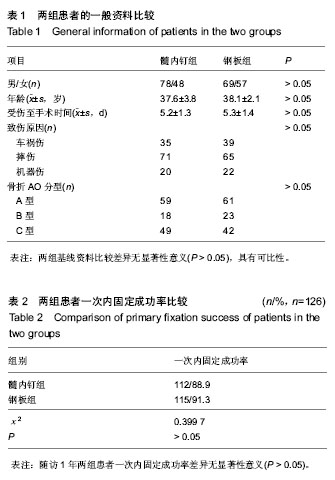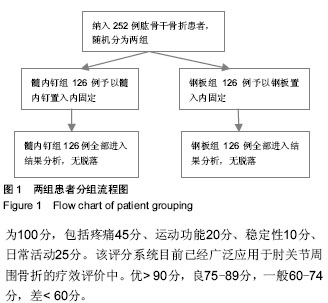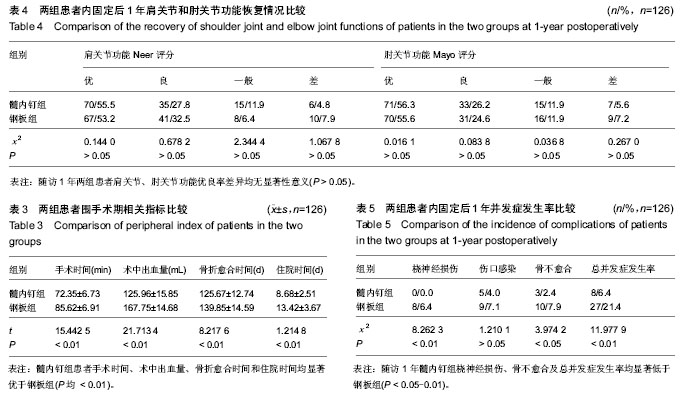中国组织工程研究 ›› 2015, Vol. 19 ›› Issue (13): 2086-2090.doi: 10.3969/j.issn.2095-4344.2015.13.022
• 骨科植入物 orthopedic implant • 上一篇 下一篇
髓内钉和钢板置入修复成人肱骨干骨折:桡神经损伤及骨不愈合发生率比较
冯 涛
- 菏泽市立医院骨创外科,山东省菏泽市 274000
Fixation with intramedullary nail and plate in the treatment of adult humeral shaft fracture: comparison of radial nerve injury and non-union rate
Feng Tao
- Department of Orthopedics Surgery, Heze Municipal Hospital, Heze 274000, Shandong Province, China
摘要:
背景:目前对于肱骨干骨折骨折,特别是伴有多发损伤患者的治疗以内固定修复为主,根据骨折复位方法和固定方式的不同,常用的修复方式包括髓内钉固定和微创钢板内固定。而如何选择一种最安全有效的内固定方式是肱骨干骨折修复的重点。 目的:探讨髓内钉和钢板置入内固定对成人肱骨干骨折的修复效果。 方法:将菏泽市立医院在2010年5月至2013年5月收治的252例肱骨干骨折患者随机均分为髓内钉组和钢板组,每组126例。髓内钉组患者采用髓内钉固定进行治疗,钢板组患者采用钢板内固定进行治疗。观察记录两组患者的手术时间、术中出血量、住院时间及骨折愈合时间等指标。内固定后随访1年,比较分析两组患者桡神经损伤、感染、骨不愈合等并发症的发生率;分别根据Neer法和Mayo法评定患者的肩关节和肘关节功能恢复情况。 结果与结论:两组患者一次内固定成功率之间差异无显著性意义(χ2=0.399 7,P > 0.05)。髓内钉组手术时间、术中出血量、骨折愈合时间和住院时间均显著优于钢板组,两组间差异有非常显著性意义(t=15.442 5,21.713 4,8.217 6,1.214 8,P均 < 0.01)。内固定后随访1年,两组患者桡神经损伤发生率差异有非常显著性意义 (χ2=8.262 3,P < 0.01);髓内钉组骨不愈合发生率显著低于钢板组,两组间差异有显著性意义(χ2=3.947 2,P < 0.05);同时髓内钉组总并发症发生率显著低于钢板组总并发症发生率,两组间差异有非常显著性意义 (χ2=11.977 9,P < 0.01);此外两组患者Neer肩关节功能评分和Mayo肘关节功能评分差异均无显著性意义(χ2=0.235 4,0.273 0,P均 > 0.05)。提示采用髓内钉和钢板置入内固定修复成人肱骨干骨折均可取得良好的临床效果,两种内固定方法各有优缺点,临床上应根据患者病情需要制定合适的内固定方案。
中图分类号:


